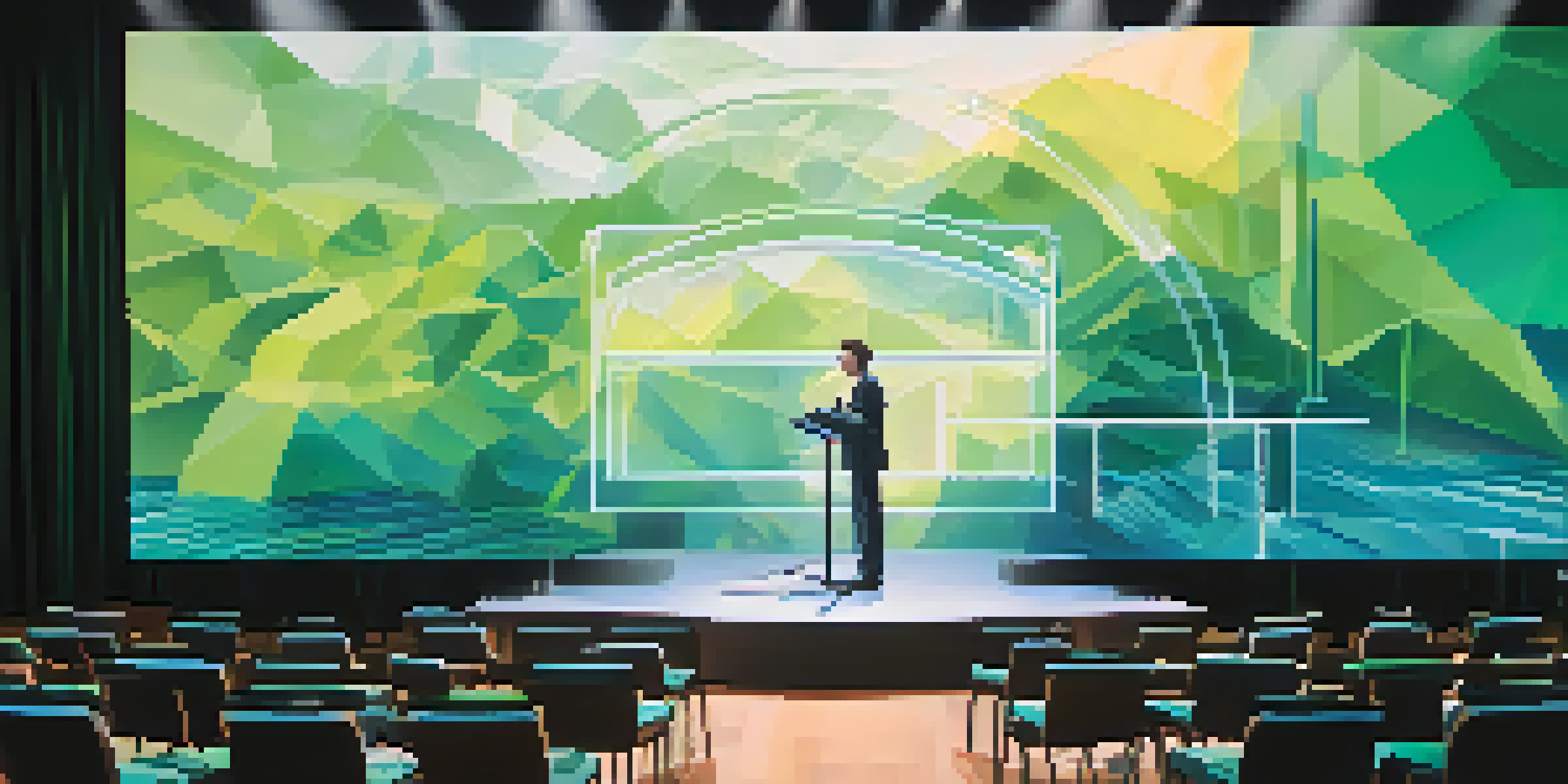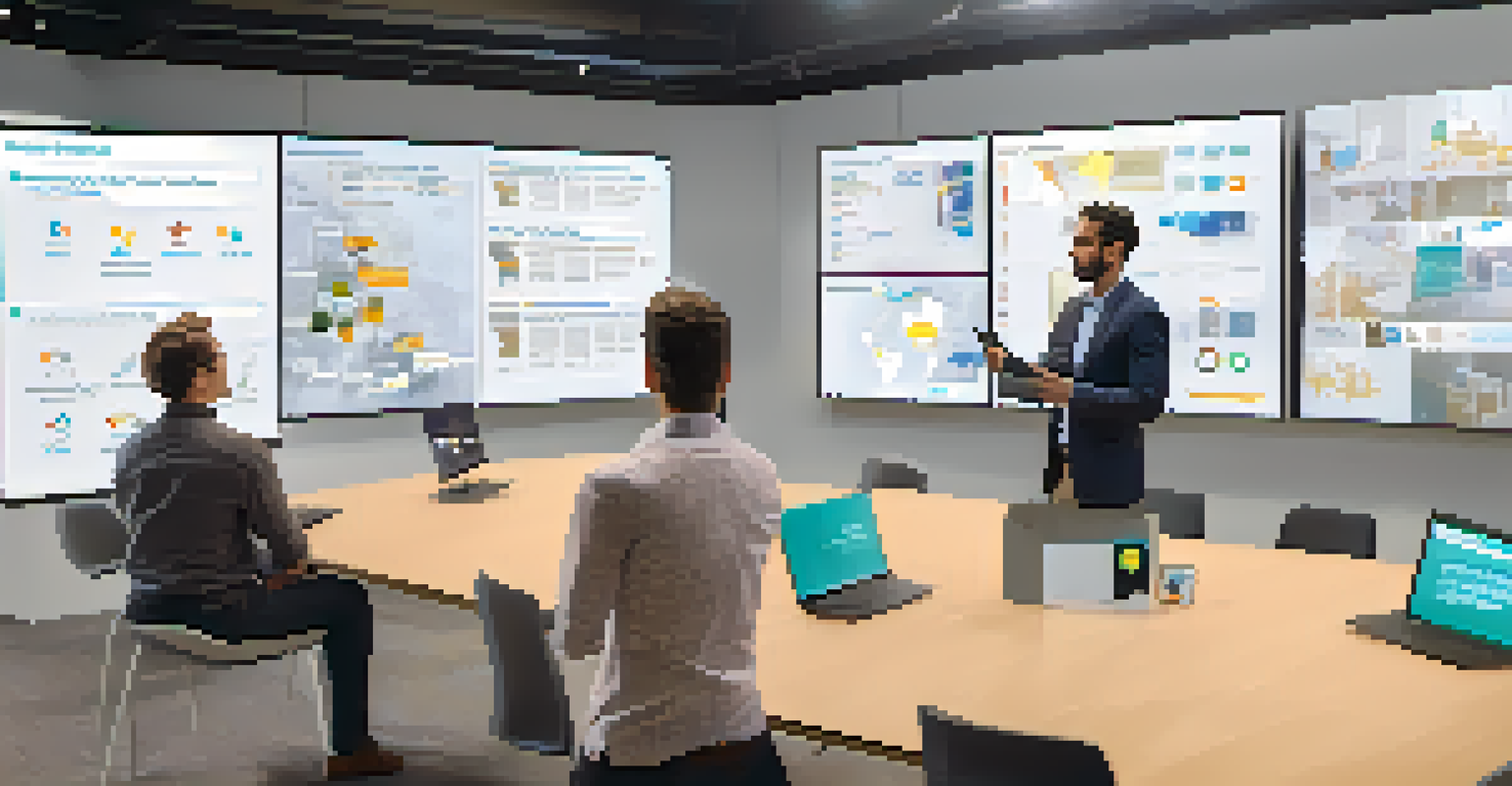Augmented Reality for Enhancing Public Speaking Skills

Understanding Augmented Reality in Public Speaking
Augmented reality (AR) is a technology that overlays digital information onto the real world, enhancing our perception of reality. Imagine giving a speech and having visual aids projected onto the stage right before your eyes, making your points clearer and more engaging. This immersive experience can help speakers connect with their audience on a deeper level, making their messages more memorable.
Augmented reality is an emerging technology that allows us to see the world around us in a new way, transforming how we interact with information.
By integrating AR into public speaking, presenters can visualize complex data or concepts instantly, allowing for clearer explanations. For instance, a speaker discussing climate change could use AR to show real-time data on rising temperatures, making the information more relatable. This innovative approach not only captivates the audience but also fosters a greater understanding of the topic at hand.
As technology continues to evolve, the potential for AR in public speaking becomes increasingly promising. With tools designed for seamless integration, speakers can harness this technology to elevate their presentations, making them more interactive and impactful. Ultimately, AR presents a unique opportunity to redefine how we communicate and engage in public speaking.
Benefits of Using Augmented Reality in Presentations
Incorporating AR into presentations offers numerous benefits that can enhance the overall experience for both speakers and audiences. First and foremost, AR can significantly reduce anxiety levels for speakers, as it allows them to focus on the visual elements rather than memorizing their scripts. With the help of digital prompts and visuals, presenters can feel more confident and poised when addressing their audience.

Moreover, AR can create a more engaging atmosphere, capturing the audience's attention from the moment the presentation begins. Imagine seeing 3D models or animations that illustrate key points, inviting the audience to explore information interactively. This heightened engagement not only makes the presentation more enjoyable but also improves information retention.
AR Enhances Audience Engagement
By incorporating interactive elements like quizzes, AR transforms passive presentations into dynamic experiences.
Finally, AR can democratize public speaking by making it more accessible to diverse individuals. For instance, those who may struggle with verbal communication can still convey their ideas effectively through visual storytelling. By breaking down barriers and enhancing communication, AR can empower more people to share their messages with confidence.
How AR Can Help Improve Delivery and Timing
One of the most challenging aspects of public speaking is mastering delivery and timing. AR can assist speakers in rehearsing their presentations by providing real-time feedback on pacing and voice modulation. Imagine practicing your speech in front of a virtual audience, where the AR system prompts you to adjust your tone or speed based on audience reactions.
The future of communication is not just about the message; it's about how we present it and engage with our audience.
Additionally, AR can facilitate better timing by helping speakers manage their presentation flow. With visual cues appearing at key moments, speakers can stay on track and ensure they cover all essential points within their allotted time. This structured approach not only enhances the overall delivery but also builds the speaker's confidence in managing their time effectively.
Ultimately, AR serves as a valuable training tool, allowing speakers to refine their skills before stepping onto the stage. By simulating real-life scenarios, speakers can practice until they feel comfortable with their material and delivery. This preparation can make all the difference in transforming a good presentation into a great one.
Engaging the Audience with Interactive Experiences
Engagement is key to a successful presentation, and AR can take audience interaction to a whole new level. By incorporating interactive elements, such as quizzes or polls that respond to the presentation in real-time, speakers can foster participation and keep the audience invested. This collaborative approach encourages a two-way conversation, making the experience more dynamic and enjoyable.
For instance, imagine a speaker asking their audience to vote on a specific topic using AR-enabled devices. The results could then be displayed visually during the presentation, allowing for instant feedback and a richer discussion. This kind of engagement not only captivates the audience but also provides valuable insights for the speaker to address.
AR Reduces Speaker Anxiety
Using AR tools allows speakers to focus on visuals, alleviating the stress of memorizing scripts.
Incorporating AR into presentations transforms the traditional lecture format into an immersive experience, making it easier for audiences to connect with the content. By turning passive listeners into active participants, AR enhances the overall learning experience and creates a more memorable event.
Overcoming Challenges with Augmented Reality
While the benefits of augmented reality in public speaking are numerous, there are challenges to consider as well. One significant hurdle is the learning curve associated with new technology. Many speakers may feel intimidated by AR tools, fearing they may not be tech-savvy enough to incorporate them effectively into their presentations.
To overcome this challenge, it's essential to invest time in training and practice. Familiarizing oneself with AR applications through workshops or online tutorials can build confidence and ensure a smoother integration of this technology into presentations. The more comfortable speakers feel with AR, the more they can leverage it to enhance their skills.
Another challenge is the potential for technical glitches during live presentations. A sudden malfunction could disrupt the flow and distract both the speaker and the audience. Therefore, it's crucial for presenters to have backup plans in place and conduct thorough rehearsals to mitigate these risks. By being prepared, speakers can focus on delivering their message, regardless of any unexpected issues.
The Future of AR in Public Speaking
As we look to the future, the role of augmented reality in public speaking is poised to grow significantly. With advancements in technology, AR tools are becoming more user-friendly and accessible, making it easier for speakers to incorporate them into their presentations. This accessibility could lead to a wider adoption of AR, changing how we approach public speaking altogether.
Moreover, the potential for AR to enhance remote presentations is particularly exciting. With the rise of virtual events and online meetings, AR can provide a sense of presence and engagement that is often lacking in traditional video calls. Imagine attending a virtual conference where speakers can use AR to bring their presentations to life, creating an immersive experience for remote attendees.
Future Growth of AR in Speaking
As technology advances, AR's accessibility will revolutionize public speaking and remote presentations.
Ultimately, the future of public speaking lies in embracing innovative tools like augmented reality. By harnessing the power of AR, speakers can continue to evolve their skills and create impactful presentations that resonate with audiences. This shift not only enriches the experience but also ensures that public speaking remains a vital and engaging form of communication.
Real-World Examples of AR in Public Speaking
Several organizations and individuals are already successfully integrating augmented reality into their public speaking efforts. For example, some educational institutions have begun using AR to enhance classroom presentations, allowing students to visualize complex concepts in real-time. This practical application not only aids understanding but also motivates students to engage more actively in discussions.
In the corporate world, companies like Microsoft have utilized AR in product demonstrations, allowing speakers to showcase their innovations interactively. By enabling potential customers to see products in action through AR, these presentations become more persuasive and impactful. This approach not only captivates audiences but also provides a hands-on experience that traditional presentations cannot match.

In summary, these real-world examples highlight the transformative power of augmented reality in public speaking. As more speakers adopt AR tools, we can expect to see a shift in how presentations are delivered, making them more engaging and effective. By learning from these pioneers, aspiring speakers can gain valuable insights into how to incorporate AR into their own presentations.